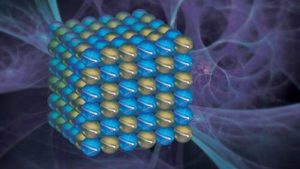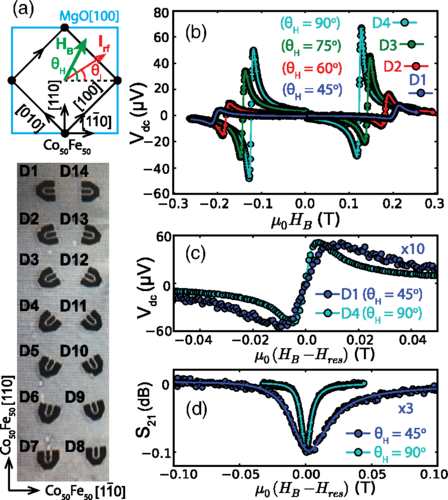R&D: Researchers Discover Surprising Quantum Effect in HDD Material
To affect information storage properties in metal alloy
This is a Press Release edited by StorageNewsletter.com on May 7, 2019 at 2:10 pmFrom Argonne National Laboratory
Scientists find surprising way to affect information storage properties in metal alloy.
Researchers at Argonne have discovered a way to control the direction of electron spin in a cobalt-iron alloy, influencing its magnetic properties. The result could have implications for more powerful and energy-efficient materials for information storage.
(Image by Argonne National Laboratory)
Sometimes scientific discoveries can be found along well-trodden paths. That proved the case for a cobalt-iron alloy material commonly found in hard disk drives.
As reported in a recent issue of Physical Review Letters, researchers from the U.S. Department of Energy’s (DOE) Argonne National Laboratory, along with Oakland University in Michigan and Fudan University in China, have found a surprising quantum effect in this alloy.
“When you drive your car down a flat highway with no wind, the dissipating energy from drag is the same regardless of the direction you travel. With the effect we discovered, it’s like your car experiences more drag if you’re traveling north-south than if you’re traveling east-west,” said Olle Heinonen, materials scientist, Argonne.
The effect involves the ability to control the direction of electron spin, and it could allow scientists to develop more powerful and energy-efficient materials for information storage. By changing the electron spin direction in a material, the researchers were able to alter its magnetic state. This greater control of magnetization allows more information to be stored and retrieved in a smaller space. Greater control could also yield additional applications, such as more energy-efficient electric motors, generators and magnetic bearings.
The effect the researchers discovered has to do with ‘damping,’ in which the direction of electron spin controls how the material dissipates energy. “When you drive your car down a flat highway with no wind, the dissipating energy from drag is the same regardless of the direction you travel.” said Olle Heinonen, materials scientist, Argonne, an author of the study. “With the effect we discovered, it’s like your car experiences more drag if you’re traveling north-south than if you’re traveling east-west.”
“In technical terms, we discovered a sizable effect from magnetic damping in nanoscale layers of cobalt-iron alloy coated on one side of a magnesium oxide substrate,” added Axel Hoffmann, materials scientist, Argonne, another author of the study. “By controlling the electron spin, magnetic damping dictates the rate of energy dissipation, controlling aspects of the magnetization.”
The team’s discovery proved especially surprising because the cobalt-iron alloy had been widely used in applications such as magnetic hard drives for many decades, and its properties have been thoroughly investigated. It was conventional wisdom that this material did not have a preferred direction for electron spin and thus magnetization.
In the past, however, scientists prepared the alloy for use by ‘baking’ it at high temperature, which orders the arrangement of the cobalt and iron atoms in a regular lattice, eliminating the directional effect. The team observed the effect by examining unbaked cobalt-iron alloys, in which cobalt and iron atoms can randomly occupy each other’s sites.
The team was also able to explain the underlying physics. In a crystal structure, atoms normally sit at perfectly regular intervals in a symmetric arrangement. In the crystal structure of certain alloys, there are slight differences in the separation between atoms that can be removed through the baking process; these differences remain in an ‘unbaked’ material.
Squeezing such a material at the atomic level further changes the separation of the atoms, resulting in different interactions between atomic spins in the crystalline environment. This difference explains how the damping effect on magnetization is large in some directions, and small in others.
The result is that very small distortions in the atomic arrangement within the crystalline structure of cobalt-iron alloy have giant implications for the damping effect. The team ran calculations at the Argonne Leadership Computing Facility, a DOE Office of Science User Facility, that confirmed their experimental observations.
The researchers’ work appears in the March 21 online edition of Physical Review Letters and is entitled, “Giant anisotropy of Gilbert damping in epitaxial CoFe films.” Argonne researchers include Yi Li, Shulei Zhang, Hyeondeok Shin, Hilal Saglam, Vedat Karakas, Ozhan Ozatay, John Pearson, Olle Heinonen, Axel Hoffmann, and Wei Zhang. Yi Li and Wei Zhang are also affiliated with Oakland University. Other contributors include Fanlong Zeng and Yizheng Wu from Fudan University.
Article: Giant Anisotropy of Gilbert Damping in Epitaxial CoFe Films
Physical Review Letters has published an article written by Yi Li,Department of Physics, Oakland University, Rochester, Michigan 48309, USA, and Materials Science Division, Argonne National Laboratory, Argonne, Illinois 60439, USA, Fanlong Zeng, State Key Laboratory of Surface Physics, Department of Physics, Fudan University, Shanghai 200433, China, Steven S.-L. Zhang, Materials Science Division, Argonne National Laboratory, Argonne, Illinois 60439, USA, Hyeondeok Shin, Computational Sciences Division, Argonne National Laboratory, Argonne, Illinois 60439, USA, Hilal Saglam, Materials Science Division, Argonne National Laboratory, Argonne, Illinois 60439, USA, and Department of Physics, Illinois Institute of Technology, Chicago Illinois 60616, USA, Vedat Karakas, Ozhan Ozatay, Materials Science Division, Argonne National Laboratory, Argonne, Illinois 60439, USA, and Department of Physics, Bogazici University, Bebek 34342, Istanbul, Turkey, John E. Pearson, Olle G. Heinonen, Materials Science Division, Argonne National Laboratory, Argonne, Illinois 60439, USA, Yizheng Wu, State Key Laboratory of Surface Physics, Department of Physics, Fudan University, Shanghai 200433, China, and Collaborative Innovation Center of Advanced Microstructures, Nanjing 210093, China, Axel Hoffmann, Materials Science Division, Argonne National Laboratory, Argonne, Illinois 60439, USA, and Wei Zhang, Department of Physics, Oakland University, Rochester, Michigan 48309, USA, and Materials Science Division, Argonne National Laboratory, Argonne, Illinois 60439, USA.
(a) Upper: crystalline structure, axes of bcc Co50Fe50 film on MgO(100) substrate, and definition of θH and θI. Lower: device orientation with respect to the CoFe crystal axis. (b) Spin-torque FMR line shapes of (i) CoFe(10 nm)|Pt devices D1 to D4 measured. (c) Resonances of D1 and D4 from (b) for μ0Hres<0. (d) Resonances of (iii) CoFe(20 nm) for θH=45° and 90° measured by VNA FMR. In (b)–(d) ω/2π=20 GHz and offset applies.
Abstract: “Tailoring Gilbert damping of metallic ferromagnetic thin films is one of the central interests in spintronics applications. Here we report a giant Gilbert damping anisotropy in epitaxial Co50Fe50 thin films with a maximum-minimum damping ratio of 400%, determined by broadband spin-torque ferromagnetic resonance as well as inductive ferromagnetic resonance. We conclude that the origin of this damping anisotropy is the variation of the spin orbit coupling for different magnetization orientations in the cubic lattice, which is further corroborated from the magnitude of the anisotropic magnetoresistance in Co50Fe50.“












 Subscribe to our free daily newsletter
Subscribe to our free daily newsletter


